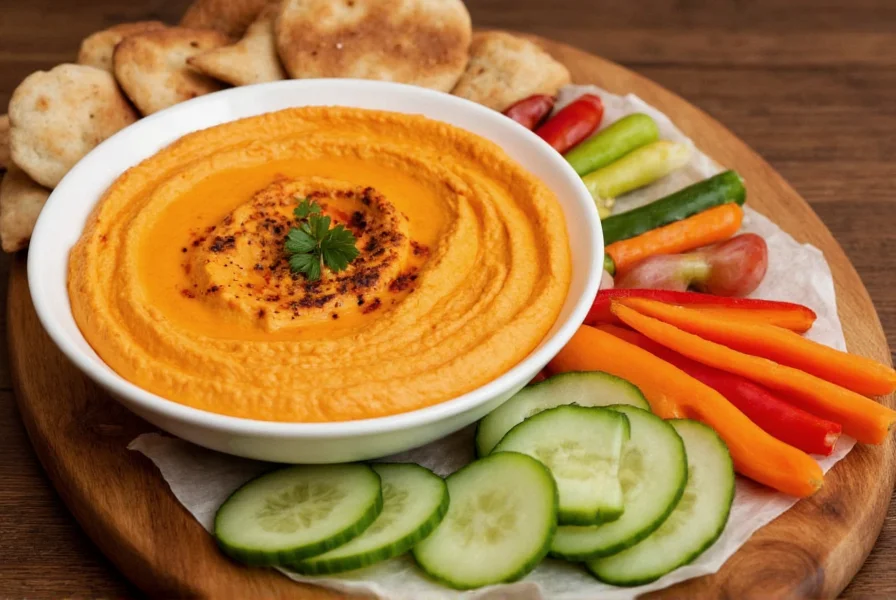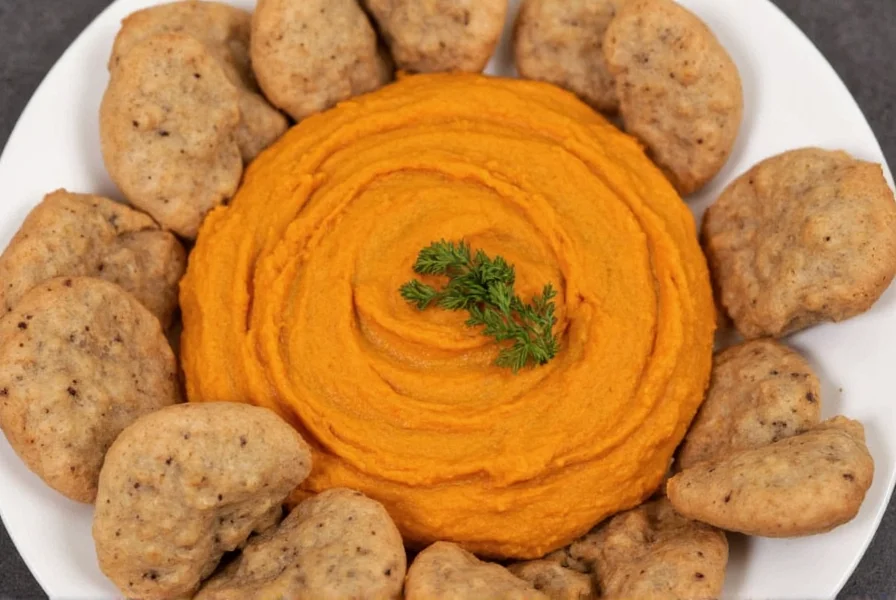Transforming ordinary chickpea dip into something extraordinary, roasted pepper hummus has become a staple in modern Mediterranean cuisine. This vibrant spread combines the earthy creaminess of traditional hummus with the sweet, smoky depth of roasted peppers, creating a versatile condiment perfect for everything from casual snacking to elegant entertaining.
The Unique Appeal of Roasted Pepper Hummus
What sets roasted pepper hummus apart from its traditional counterpart? The magic happens during the roasting process. When bell peppers undergo controlled heat exposure, their natural sugars caramelize, developing complex flavor compounds that add dimension to the familiar chickpea base. Unlike raw pepper additions, roasted peppers blend seamlessly into the hummus, creating a smooth texture without compromising the dip's signature creaminess.
Professional chefs and home cooks alike appreciate how roasted red pepper hummus recipe variations can adapt to different culinary contexts. The sweetness of roasted peppers balances the tanginess of lemon juice while complementing the nuttiness of tahini, creating a harmonious flavor profile that appeals to diverse palates.

Essential Ingredients for Perfect Roasted Pepper Hummus
Creating exceptional roasted pepper hummus requires attention to ingredient quality and preparation techniques. While basic recipes share common elements, subtle variations significantly impact the final product's texture and flavor.
| Ingredient | Traditional Hummus | Roasted Pepper Hummus | Why It Matters |
|---|---|---|---|
| Peppers | None | 1-2 roasted bell peppers | Provides sweet, smoky flavor and vibrant color |
| Chickpeas | 1.5 cups | 1.25 cups | Slightly reduced to balance pepper flavor |
| Lemon Juice | 3 tbsp | 2.5 tbsp | Reduced to complement pepper sweetness |
| Tahini | 1/4 cup | 1/3 cup | Increased to balance pepper acidity |
Mastering the Roasting Process
The quality of your roasted peppers directly impacts the final hummus. For best results, use fresh, firm bell peppers with deep color. While red bell peppers remain the most popular choice for roasted red pepper hummus due to their sweetness, adventurous cooks might experiment with poblano or Anaheim peppers for subtle heat variations.
Professional kitchens typically roast peppers over open flames, but home cooks can achieve excellent results using these methods:
- Oven method: Place whole peppers on a baking sheet under the broiler, turning occasionally until completely blackened (15-20 minutes)
- Stovetop method: Hold peppers with tongs directly over a gas flame, rotating until evenly charred
- Alternative: Use high-quality jarred roasted peppers when fresh options aren't available
After roasting, place peppers in a covered bowl for 10 minutes to steam, then carefully remove skins. Properly roasted peppers should have a jam-like consistency that blends smoothly into the hummus base without creating texture issues.
Serving Suggestions That Elevate Your Experience
Understanding roasted pepper hummus serving suggestions transforms this simple dip into a culinary centerpiece. Beyond the traditional pita and vegetable dippers, consider these creative applications:
- As a sandwich spread that adds moisture and flavor without overpowering other ingredients
- Thinned with olive oil and lemon juice as a vibrant salad dressing
- As a pizza base alternative for Mediterranean-inspired flatbreads
- Swirled into grain bowls for added protein and visual appeal
- As a flavorful binder in vegetarian burgers or meatloaf
When hosting gatherings, easy roasted pepper hummus for parties shines as a make-ahead appetizer. Its vibrant color creates visual interest on platters, while its balanced flavor profile appeals to diverse dietary preferences including vegan and gluten-free guests.

Nutritional Benefits Worth Noting
Healthy roasted pepper hummus nutrition makes it an excellent addition to balanced diets. The combination of chickpeas and roasted peppers delivers:
- Complete plant-based protein from chickpeas
- Vitamin C boost from roasted peppers (significantly higher than raw peppers)
- Dietary fiber supporting digestive health
- Heart-healthy monounsaturated fats from tahini
- Natural antioxidants from both chickpeas and peppers
A standard two-tablespoon serving contains approximately 70-90 calories, making it a nutrient-dense option compared to many commercial dips. When comparing homemade roasted pepper hummus vs store bought options, homemade versions typically contain fewer preservatives and allow for customization of sodium and fat content.
However, roasted pepper hummus may not be suitable for all dietary needs. According to the Academy of Nutrition and Dietetics (https://www.eatright.org/health/well-being/prevention-and-wellness/managing-ibs-with-the-low-fodmap-diet), individuals with irritable bowel syndrome (IBS) following a low-FODMAP diet should limit chickpeas and garlic. Additionally, the National Institute of Diabetes and Digestive and Kidney Diseases (https://www.niddk.nih.gov/health-information/digestive-diseases/acid-reflux-ger-gerd-adults/eating-diet-nutrition) notes that acidic ingredients like lemon juice may worsen symptoms for those with gastroesophageal reflux disease (GERD).
Consumer Reception and Market Trends
Roasted pepper hummus has gained significant traction in the marketplace, with consumer reception reflecting strong preference for its balanced flavor profile. A 2021 sensory study published in the journal Foods, conducted by researchers at the University of Massachusetts, evaluated consumer acceptance of various hummus flavors. The study found that roasted red pepper hummus scored 4.2 out of 5 for overall liking among 200 participants, ranking second only to classic hummus. Notably, 78% of participants indicated they would purchase roasted red pepper hummus regularly, citing its 'sweet-smoky complexity' as a key differentiator (https://www.mdpi.com/2304-8158/10/11/2735).
Perfecting Your Technique: Pro Tips
Even experienced cooks encounter challenges when making roasted pepper hummus. These professional techniques ensure consistent results:
- Texture control: For ultra-smooth hummus, remove chickpea skins before blending
- Flavor balancing: Adjust lemon juice gradually after adding roasted peppers, as their acidity varies
- Emulsion secrets: Blend tahini with liquid ingredients first to create a stable base
- Chilling time: Allow finished hummus to rest for at least 2 hours for flavors to meld
- Smoky enhancement: Add a tiny pinch of smoked paprika for deeper roasted notes
When troubleshooting common issues, remember that excess liquid from peppers is the most frequent cause of thin hummus. Strain roasted peppers thoroughly or adjust liquid ingredients accordingly. For best results with smoky roasted pepper hummus variations, use high-quality smoked sea salt rather than liquid smoke for more natural flavor.
Frequently Asked Questions
Can I use jarred roasted peppers for homemade hummus?
Yes, high-quality jarred roasted peppers work well when fresh options aren't available. Drain them thoroughly and pat dry with paper towels to remove excess liquid that could thin your hummus. Look for peppers packed in water rather than oil for better flavor control.
How long does homemade roasted pepper hummus stay fresh?
Properly stored in an airtight container, homemade roasted pepper hummus maintains freshness for 4-5 days in the refrigerator. The acidity from lemon juice helps preserve it, but always check for signs of spoilage like sour smell or mold before consuming.
What's the best way to achieve restaurant-quality smoothness?
For ultra-smooth texture, remove skins from cooked chickpeas before blending. Process ingredients in stages: first blend tahini with lemon juice until creamy, then add chickpeas, followed by roasted peppers. Use ice-cold water instead of room temperature liquid and blend for at least 3-4 minutes for optimal smoothness.
Can roasted pepper hummus be frozen successfully?
Yes, roasted pepper hummus freezes well for up to 3 months. Portion into ice cube trays for convenient single servings, then transfer to freezer bags. Thaw overnight in the refrigerator and stir well before serving, adding a teaspoon of water or lemon juice if needed to restore texture.
Which peppers work best for a sweeter hummus flavor?
Red bell peppers provide the sweetest flavor profile for roasted pepper hummus due to their longer ripening time on the vine. For even sweeter results, select peppers with three or four lobes at the base, which typically contain more sugar and fewer seeds than those with two lobes.











 浙公网安备
33010002000092号
浙公网安备
33010002000092号 浙B2-20120091-4
浙B2-20120091-4